Music Therapy Board Certification Exam – Flashcards
Unlock all answers in this set
Unlock answersquestion
Music therapy
answer
"The clinical and evidence-based use of music interventions to accomplish individual goals within a therapeutic relationship by a credentialed professional who has completed an approved music therapy program" (AMTA, 2015).
question
Education for All Handicapped Children Act
answer
Public Law 94-142; passed in 1975 to call for mainstreaming of students with disabilities into public schools in the United States ("free and appropriate" education)
question
Individualized Education Program (IEP)
answer
Developed in 1978 through IDEA to improve the education of students with disabilities who are qualified for special education in the United States; written plan that includes an assessment of the student's strengths and limitations, concrete goals and objectives for education, a list of the people administering the program, related services, and methods for evaluation
question
American Music Therapy Association (AMTA)
answer
The national organization that represents the field of music therapy in the United States today; promotes awareness of the profession, advances clinical and scientific knowledge in the field, and sets and maintains the standards of music therapy practice
question
Iso principle
answer
The concept that music should be chosen to initially match the mood state of a client and adjusted gradually to the desired mood state; described in Kircher's (1602-1680) theory of temperaments and affections, in the dissertation of Samuel Mathews in 1806, and by Esther Gatewood in 1920; termed in the 1940s by Ira Altshuler
question
National Association for Music Therapy
answer
Established in 1950; first national organization to represent the field of music therapy; signaled the birth of the music therapy profession
question
American Association for Music Therapy
answer
Established in 1971; originally called the Urban Federation for Music Therapists (UFMT); the second national organization that represented the field of music therapy; merged with the NAMT in 1998 to form the AMTA
question
Board Certification exam
answer
Established in 1985 by the NAMT and the AAMT to increase the credibility of the field of music therapy; an exam taken by a music therapy student to measure his or her knowledge of music therapy principles and foundations, clinical theories and techniques, general knowledge about music, and professional roles and responsibilities
question
Sensorimotor
answer
The first stage of Piaget's theory of development that takes place between the ages of zero and two; the child learns through his or her senses and motor movements New musical activities: listening to lullabies, listening to speech and environmental sounds, being rocked, vocal play, babbling, and moving rhythmically to music
question
Infant-directed speech

answer
An innate speech tendency used with infants that is characterized as high in pitch, exaggerated in affect and speech contour, and drawn out
question
Preoperational

answer
The second stage in Piaget's theory of development that takes place between the ages of two and seven; the child's language and conceptual skills and interpersonal awareness increase New musical activities: playing musical instruments, coordinating gross and fine motor movements to music, singing songs, improvising melodies, and participating in musical games
question
Parallel play
answer
The mode of playing during which two or more children engage in the same activity without interacting with each other
question
Beat competency
answer
The ability to follow and maintain a simple, steady beat
question
Concrete operations
answer
The third stage of Piaget's theory of development that takes place between the ages of 7 and 11; the child can think systematically and solve problems within his or her reality New musical activities: learning and playing an instrument, reading musical notation, performing in an ensemble
question
Formal operations

answer
The fourth stage of Piaget's theory of development that takes place between the ages of 11 and adulthood; the child can think abstractly; new musical activities: composition
question
Elements of music
answer
Pitch, intensity, duration, and timbre
question
Functions of music
answer
Proposed by Alan Merriam in 1964; physical engagement, communication, emotional expression, aesthetic enjoyment, entertainment, integration of society, conformity to social norms, validation of social institutions and religious rituals, symbolic representation, and continuity and stability of culture
question
Tactile
answer
Referring to the sense of touch
question
The Bonny Method of Guided Imagery and Music (GIM)
answer
A music therapy approach created by Hellen Bonny that involves listening to classical music from a relaxed state and experiencing internal imagery while a music therapist provides verbal guiding interventions in order to expand self-awareness, enhance creativity, develop spirituality, and achieve a healthier state of being
question
Attention
answer
The act of attending to a stimulus of interest; this can be shifted, divided, or sustained
question
Perception

answer
The brain's way of processing information received through the senses; involves recognition, organization, synthesis, filtering, and meaning
question
Good Gestalts
answer
According to Gestalt psychology, the principle that figures and patterns tend to be perceived in the most stable form as sensory input will allow; a whole
question
Memory
answer
The storage and retrieval of information in the brain
question
Retrieval
answer
The re-accessing of long-term memories stored in the brain
question
Encoding
answer
The storage of memories
question
Mnemonic device
answer
A memory tool
question
Long-term memory
answer
Information that is rehearsed and stored in the brain and is accessible for a long period of time, sometimes throughout life
question
Safety valve function
answer
The use of music to express disapproval of a social reality or deep-felt emotions
question
Extramusical associations
answer
A thought, emotion, or sensation experienced in response to a sound that represents something nonmusical; e.g. linking a bell tone to the end of class
question
Cultural convention
answer
A set of common standards or social norms in a group of people; e.g. in Western music, the dominant triad leads to the tonic triad
question
Referentialist philosophy
answer
The principle that music finds its meaning in the symbolic representation of nonmusical ideas or events
question
Iconicity
answer
The use of musical structures to represent a feeling, object, or event; i.e. word painting, tone painting, text depiction
question
Isomorphism
answer
In Gestalt psychology, the principle that there is a parallel between Gestalt perception of a pattern and the actual experience of the pattern structure in the brain; in music, the principle that the structural characteristics of music can mimic human emotions or behaviors
question
Association through contiguity
answer
The connection between two events that occur in proximity; e.g. hearing a piece of music that stimulates memories of an event during which the piece was heard
question
Expressionism
answer
The philosophical concept that the elements of music itself enable music to elicit emotional responses and take on meaning
question
Optimal complexity theory
answer
Proposed by Berlyn in 1971; the belief that a balance of familiarity and complexity can elicit a pleasurable emotional response from music
question
Theory of expectations
answer
Proposed by Leonard Meyer; the belief that musical surprises elicit pleasurable emotional responses
question
Cue Redundancy model
answer
A theory proposed by Balkwill and Thompson in 1999 that some musical cues are universal while other musical cues are culture specific
question
Intellectual disability
answer
Originally referred to as mental retardation; a developmental disability marked by decreased intellectual capacity and impaired adaptive behavior that manifests before age eighteen; causes are biomedical, environmental, and educational and can occur prenatally, perinatally, or postnatally; IQ is 70 or less
question
Down's Syndrome
answer
A developmental disability caused by the genetic mutation trisomy 21, causing intellectual disability and physical abnormalities
question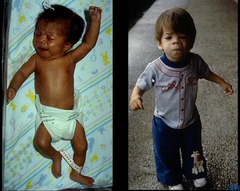
Fetal alcohol syndrome

answer
A disorder that is caused by alcohol consumption of the mother during gestation, resulting in intellectual disabilities, attention problems, growth deficiencies, and/or facial deformities
question
Fragile X syndrome
answer
A disorder that is caused by genetic mutation on the X chromosome, causing intellectual disability
question
Etiology
answer
The cause or origin of a condition
question
Meningitis
answer
A disease that is caused by an infection of the spinal fluid, leading to possible hearing problems or potential death
question
Encephalitis
answer
The swelling or infection of the brain
question
Genetic abnormalities
answer
Broken, damaged, or missing genetic material, causing disability
question
Metabolic errors
answer
Conditions that prevent the body from successfully breaking down substances
question
Hydrocephaly
answer
A condition caused by excess cerebrospinal fluid in and around the brain
question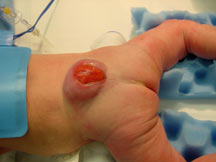
Spina bifida

answer
A congenital condition caused by an open defect in the spinal column resulting from a failure of the vertebrae to close; may result in paralysis, loss of sensation, or intellectual disability
question
Executive function
answer
The ability to make decisions moment by moment and carry out actions with intention
question
Hypotonia
answer
Lack of muscle tone
question
Atlantoaxial instability
answer
A misalignment of the upper spinal column that is often found in people with Down syndrome
question
Self-injurious behavior
answer
Harmful behavior inflicted on one's self due to frustration
question
Individuals with Disabilities Education Act (IDEA)
answer
Public Law 101-476; established in 1990 to strengthen the Education for All Handicapped Children Act; a federal special education law that specifies who is eligible for services and what the nature of those services are; requires zero reject, nondiscriminatory evaluation, free and appropriate education, least restrictive environment, procedural due process, and parent and student participation
question
Multidisciplinary assessment
answer
The assessment of the needs, strengths, and limitations of a student with a disability conducted by professionals from a variety of disciplines
question
Least restrictive environment (LRE)
answer
In IDEA, a call to mainstream students with disabilities as much as possible in the classroom with developmentally normal peers with the provision of supports and services
question
Medical model
answer
A model of treatment that focuses primarily on the physical care of a patient
question
Autism spectrum disorder
answer
A pervasive developmental disability that was first described by Leo Kanner in 1943; characterized by difficulties in communication, socialization, behavior, and cognition; caused by uneven or delayed development; challenges vary from person to person
question
Pervasive developmental disorders (PDD)
answer
A group of disorders that are characterized by deficits in communication and socialization; includes Asperger's syndrome, Rett's syndrome, and autism
question
Asperger's syndrome
answer
A condition on the autism spectrum that is characterized by stereotypical repetitive behaviors and deficits in socialization; language and communication skills develop normally
question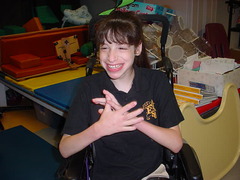
Rett's syndrome

answer
Disorder that manifests in females resulting from the slowing of head growth after two and a half years of age; characterized by deficits in language and communication, socialization, and physical coordination
question
Echolalic
answer
Speech in which previously spoken words and phrases are repeated without meaning
question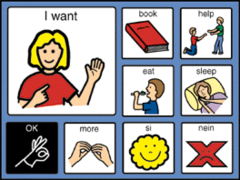
Alternative and augmentative communication (AAC) system

answer
A device or method that is used to facilitate communication for a person with communication deficits; examples include sign language, picture/symbol boards/books/wallets, letter/word boards, voice output devices, and visual tracking devices
question
Picture exchange communication system (PECS)
answer
An AAC system that involves a person using a picture or symbol to represent a want or need; typically used as an aid by children with autism
question
Stereotypical behaviors
answer
Stimulative, repetitive behaviors such as flapping, rocking, and vocalizing on vowel sounds
question
Positive behavioral supports
answer
A system that involves identifying the causes of problematic behavior and determining strategies to replace the behavior
question
Auditory awareness
answer
The ability to distinguish between sound and silence
question
Auditory discrimination
answer
The ability to determine the differences and/or similarities between two or more sounds
question
Localization
answer
The ability to determine the location of a sound
question
Expressive language
answer
The use of verbal or nonverbal communication (e.g. speech, sign, facial expressions, gestures)
question
Receptive language
answer
The ability to listen and understand verbal or nonverbal language
question
Sound identification
answer
The ability to determine the source of a sound
question
Congenital
answer
A condition that presents itself at birth
question
Chronic
answer
A genetically caused condition that presents itself later in life
question
Acquired/adventitious
answer
A condition that is caused by trauma, disease, or disorders of growth and development after birth
question
Cerebral palsy
answer
A congenital and/or chronic condition resulting from damage to the motor cortex; results in problems with movement, posture, and muscle control; types include spasticity, athetosis, rigidity, mixed type, atonia, ataxia, and tremor; may affect one or more limbs of the body
question
Muscular dystrophy
answer
A congenital and/or chronic progressive condition in which the muscles gradually degenerate and are replaced by fat and fibrous tissues
question
Clubfoot

answer
A congenital condition in which the feet are inverted with the heel drawn up and the forefoot bent inward
question
Congenital dislocation of the hip
answer
A congenital condition in which the hip bones develop abnormally during gestation
question
Arthrogryposis
answer
A congenital condition in which the joints are rigid and fixed and the muscles are weak
question
Juvenile rheumatoid arthritis
answer
A condition that occurs two times during childhood during which one or more of the joints are inflamed
question
Dwarfism
answer
A congenital condition resulting from the abnormal development of the skeleton; the head and trunk are often normal in size and the limbs are shorter
question
Osteogenesis imperfecta
answer
A congenital or chronic condition resulting in brittleness of the bones; locomotion is limited or impossible
question
Thermal injuries
answer
Burns to the skin resulting from fire, chemicals, electricity, radiation, or prolonged contact with extreme degrees of hot or cold liquids
question
Spinal cord injuries
answer
Injury that causes damage to the spinal cord, resulting in paralysis (paraplegia or quadriplegia); causes may include motor vehicle accidents, falls, sports accidents, or bullet wounds
question
Acquired amputations
answer
Loss of a limb due to motor vehicle accidents, farm accidents, power tool accidents, gunshot injuries, cancer, infections, bone tumors, vascular conditions, etc.
question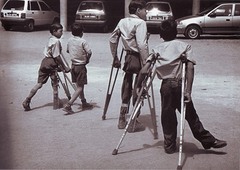
Poliomyelitis

answer
An acquired disease caused by a virus that damages the motor neurons in the spinal cord, often resulting in paralysis
question
Rhythmic Auditory Stimulation (RES)
answer
A neurologic music therapy technique used in gait training; a steady rhythmic stimulus serves as a cue for initiating and sustaining steady locomotion; can improve balance, trajectory fluidity, tempo, coordination, etc.
question
Patterned Sensory Enhancement (PSE)
answer
A neurologic music therapy technique that makes use of sound patterns to elicit functional movements (e.g. ascending melodic line to facilitate lifting of arms); used to improve balance and posture, increase physical strength and endurance, and increase functional motor skills of the upper limbs
question
Therapeutic Instrumental Music Performance (TIMP)
answer
A neurologic music therapy technique that makes use of instrument playing to prompt functional motor movements; can improve spatial perception, endurance, timing of movements, strength, flexibility, range of motion, functional hand movements, finger dexterity, limb coordination, etc.
question
Melodic Intonation Therapy (MIT)
answer
A neurologic music therapy technique developed for expressive aphasia rehabilitation that teaches simple speech by matching the inflection and rhythmic attributes of short phrases to musical prosody; utilizes the patient's unimpaired ability to sing
question
Rhythmic Speech Cuing (RSC)
answer
A neurologic music therapy technique developed for apraxia, dysarthria, and fluency disorder rehabilitation that improves the initiation and rate of speech by providing a steady rhythmic beat and patterned cues with a client's hand, a drum, or a metronome
question
Vocal Intonation Therapy (VIT)
answer
A neurologic music therapy technique that addresses the inflection, dynamics, pitch, loudness, timbre, breathing, and prosidy of speech through vocal exercises similar to those used by choir conductors
question
Therapeutic Singing (TS)
answer
A neurologic music therapy technique that addresses the initiation, development, articulation, and breathing involved in speech using unspecified singing experiences
question
Oral Motor and Respiratory Exercises (OMREX)
answer
A neurologic music therapy technique developed to use with people with developmental disabilities, dysarthria, and muscular dystrophy that addresses the rehabilitation of the speech and respiratory apparatuses through sound vocalization and wind instrument playing
question
Musical Speech Stimulation (MUSTIM)
answer
A neurologic music therapy technique used in apraxia and aphasia rehabilitation that addresses the acquisition of nonpropositional language through the use of familiar tunes; the client fills in the missing word when prompted with space
question
Developmental Speech and Language Training Through Music (DSLM)
answer
A neurologic music therapy technique that addresses the development of general speech and language skills through age-appropriate musical experiences, including singing, chanting, playing musical instruments, and combining music, speech, and movement; often used in group settings
question
Symbolic Communication Training Through Music (SYCOM)
answer
A neurologic music therapy technique that uses improvisational and performance experiences to teach communication behavior, language pragmatics, appropriate speech gestures, and emotional nonverbal communication
question
Musical Sensory Orientation Training (MSOT)
answer
A neurologic music therapy technique that addresses sensory stimulation; arousal and recovery of wake states; meaningful responsiveness; orientation to time, place, and person; vigilance; and concentration; exercises may include composing a simple song containing identifying information, playing an instrument at a certain time in a song, watching the therapist play an instrument, etc.; use of preferred and/or familiar music is most effective
question
Musical Neglect Training (MNT)
answer
A neurologic music therapy technique that addresses visual neglect through active or receptive musical exercises; instruments are structured in time, tempo, and rhythm and configured in the space appropriately; e.g. playing an instrument bilaterally or listening to sounds from different directions
question
Auditory Perception Training (APT)
answer
A neurologic music therapy technique that involves exercises that address the identification and discrimination of the components of sounds, including pitch, duration, tempo, rhythmic patterns, time, timbre, and speech sounds; exercises may include playing from symbolic or graphic notation, using tactile sound transmission, or integrating movement to music
question
Musical Attention Control Training (MACT)
answer
A neurologic music therapy technique that improves attention through active or receptive musical exercises in which musical elements cue different musical responses; promotes attending to specific structural elements or form of music
question
Musical Mnemonics Training (MMT)
answer
A neurologic music therapy technique that trains the encoding and decoding of information by sequencing nonmusical information in a song, rhyme, or chant
question
Associative Mood and Memory Training (AMMT)
answer
A neurologic music therapy technique that links the learning of information to a mood state in order to promote retention
question
Musical Executive Function Training (MEFT)
answer
A neurologic music therapy technique that addresses problem solving, comprehension, organization, decision making, and reasoning skills through improvisation and composition exercises within a social setting
question
Geriatrics
answer
A scientific subspecialty concerned with the care of elderly people and the treatment of their health problems
question
Gerontology
answer
The study of aging, the characteristic behaviors of older adults, and disorders that begin in older adulthood
question
Senescence
answer
The natural degeneration of the body over time
question
Ageism
answer
The discrimination against people based on age; often involves the youth and the elderly
question
Dementia
answer
A condition marked by cognitive impairment and behavioral issues that interfere with activities of daily living and reduce quality of life; symptoms often include inaccessibility of memories, deficits in abstract thinking, problems with judgment, and impaired problem solving skills
question
Alzheimer's disease
answer
A type of dementia that is caused by damaged neuronal proteins and the buildup of plaque in the brain; symptoms include a steady decline in cognition and functioning
question
Parkinson's disease
answer
A degenerative, progressive, chronic condition characterized by damage to central nervous system; symptoms may include tremors, muscular rigidity, slowness and poverty of movement, and postural instability; caused by decreased levels of dopamine to the basal ganglia
question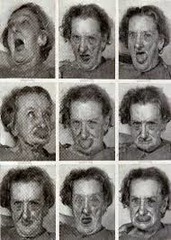
Tardive dyskinesia

answer
A condition caused by the intake of certain medications over a long period of time; symptoms may include involuntary facial grimaces, rocking, unusual lip and tongue movements, and movement of the arms and legs
question
Osteoarthritis
answer
The inflammation of the joints, cartilage covering, and bone; can affect hands, hips, spine, shoulders, and knees
question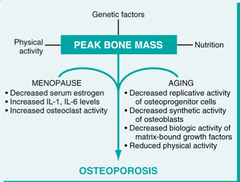
Osteoporosis

answer
The reduction in bone mass, resulting in brittleness and increased risk of fracture
question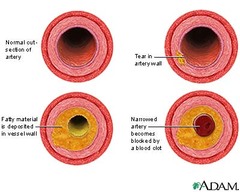
Atherosclerosis

answer
Coronary heart disease; the buildup of fibrofatty plaques in the coronary artery, increasing the risk of stroke or heart attack
question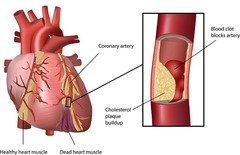
Arteriosclerosis

answer
The hardening and thickening of the arteries, which restricts blood flow to the brain and can result in hypertension and possibly lead to mental impairment
question
Myocardial infarction (MI)
answer
Heart attack; the blockage of an artery, decreasing blood supply to the heart and reducing blood pressure
question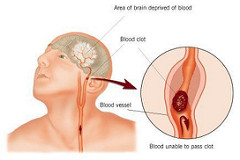
Cerebrovascular accident (CVA)

answer
Stroke, apoplexy; results from the lack of oxygen to the brain, causing brain damage; causes include ischemia (blockage of an artery), intracranial hemorrhage (bleeding in the brain), and brain tumors; severity of stroke depends on a) cause, b) quantity of brain tissue damaged, c) effects after the stroke, d) person's health status prior to the stroke, and e) location of damage in the brain; may result in aphasia, paralysis, or incontinence
question
Glaucoma
answer
A buildup of fluid in the eye, resulting in pressure and possible blindness
question
Cataracts

answer
Clouding of the lens of the eye
question
Presbycusis
answer
A deterioration of the auditory system beginning with higher frequency sounds and progressing to lower frequency sounds
question
Chronic obstructive pulmonary disease/disorder (COPD)
answer
A disorder caused by poor ventilation of the lungs; stress is put on the heart; caused by exposure to air pollutants or tobacco smoke or recurring chronic respiratory infections; symptoms include dyspnea, fatigue, and eventual death
question
Bronchitis
answer
The inflammation of the bronchis, causing restricted air flow to the lungs, an increase in mucus production, and coughing
question
Gastritis
answer
The inflammation of the stomach lining
question
Ulcers
answer
Disintegration of the stomach lining, causing abdominal pain, weight loss, and dehydration
question
Diverticulitis
answer
The inflammation of diverticuli, or bulges in the intestines, causing pain, changes in bowel movements, and nausea
question
Diabetes
answer
The insufficient production of insulin by the pancreas, causing an imbalance in blood sugar levels
question
Behavioral-emotional disorder
answer
A disorder in which a person experiences behaviors and/or emotions that are deemed "abnormal" within a given culture, society, or situation; parameters that are considered include frequency, duration, and intensity of the "abnormal" experiences
question
DSM-V
answer
The fifth edition of the Diagnostic and Statistical Manual of Mental Disorders published in 2013 by the American Psychiatric Association (APA); systematically organizes and categorizes mental illnesses
question
Milieu therapy
answer
A structured environment providing supportive therapies such as counseling, vocational rehabilitation, and recovery groups
question
Schizophrenia
answer
"Splitting of the mind;" a thought disorder in which a person becomes out of touch with reality; signs include psychosis, isolation, irregular sleep patterns, and changes in appetite; present in 1% of the population; onset age is typically in early 20s; treated with medication (neuroleptics and antipsychotics like Haldol) and psychosocial therapies
question
Psychosis
answer
The experience of being out of touch with reality
question
Positive symptoms of schizophrenia
answer
Delusions (unshared beliefs that are not reality-based - persecution, grandeur, control, or romance), hallucinations (sensory experiences that are not stimulated by the environment), disorganized thought & speech, and disorganized/catatonic behavior
question
Negative symptoms of schizophrenia
answer
Blunt/flat affect, avolition (lack of energy, spontaneity, or initiative), anhedonia (lack of interest in pleasurable activities), and attention deficit (difficulty with focusing)
question
Mood disorders
answer
Behavioral-emotional disorders that are characterized by abnormal shifts in mood (episodes); treated with medication and psychotherapy
question
Clinical depression

answer
Dysthymia; a mental illness characterized by a loss of interest in previously enjoyable activities and two of the following markers: changes in sleep patterns, guilt, lack of energy, decreased concentration, changes in appetite, psychomotor agitation, suicidal ideation, and helplessness (SIGECAPS-H); symptoms are present two years for adults and one year for children
question
Major depression
answer
A sudden, unexpected, intense loss of interest that has a duration of 1-2 weeks with at least four markers of clinical depression
question
Mania
answer
An emotional state in which a person experiences at least three of the following symptoms: distractibility, decreased interest in activities, grandiosity, flight of ideas, agitation, sleeplessness, or talking excessively (DIGFAST)
question
Bipolar disorder
answer
A mood disorder characterized by a vacillation of depressive and manic episodes; manic episode must last at least 7 days and be characterized by at least three of the markers for mania
question
Hypomanic episode
answer
An episode that lasts four 4 days
question
Schizoaffective disorder
answer
A combination of a mood disorder and schizophrenia
question
Paranoid schizophrenia
answer
A type of schizophrenia in which a person experiences paranoia
question
Psychotherapy
answer
Talk therapy; involves consulting a professional about one's mental illness
question
Cognitive-behavioral therapy (CBT)
answer
A type of psychotherapy that facilitates the cognitive restructuring of thoughts that stimulate anxiety and/or fear to change behaviors
question
Post-Traumatic Stress Disorder (PTSD)

answer
A disorder that is caused by hearing, witnessing, or experiencing an extremely traumatic event such as rape, abuse, maltreatment, neglect, war, natural disaster, death, illness, random act of violence, hostage, kidnapping, or car accident; symptoms include nightmares, night terrors, flashbacks, startled response, withdrawal, substance abuse, suicidal ideation or attempt, paranoia, insomnia, violent episodes of rage, or depression
question
Panic disorder
answer
An anxiety disorder in which a person experiences at least four uncued panic attacks within a four-week period; symptoms of panic attacks include sweating, nausea, muscle tension, fainting, nervousness, dizziness, and/or pounding heart
question
Seperation trauma/anxiety
answer
An anxiety disorder in which a person experiences anxiety when separated from a significant person; typically occurs during childhood
question
Selective mutism
answer
A condition in which a person chooses not to speak
question
Phobia
answer
An intense, irrational fear
question
Pseudophobia
answer
An intense, rational fear
question
Simple/specific phobia
answer
An intense, irrational fear of a certain object or situation
question
Agoraphobia

answer
The fear of having a panic attack in public without receiving aid
question
Social anxiety disorder
answer
An anxiety disorder characterized by anxiety in social situations
question
Generalized anxiety disorder
answer
An anxiety disorder characterized by nebulous anxiety in all situations
question
Obsessive compulsive disorder (OCD)

answer
A disorder in which a person experiences obsessions (repetitive thoughts) that cause anxiety; he or she engages in compulsions (repetitive behaviors or rituals) to reduce the anxiety
question
Body dysmorphia
answer
An OCD related disorder in which a person is dissatisfied with a body part or his/her entire body
question
Hoarding

answer
An OCD related disorder in which a person keeps large amounts of objects in a living space in order to feel safe
question
Trichotillomania
answer
An OCD related disorder in which a person compulsively pulls his or her hair in order to relieve anxiety
question
Excoriation
answer
An OCD related disorder in which a person compulsively picks at his/her skin in order to relieve anxiety
question
Acute PTSD
answer
An experience of PTSD that lasts less than six months
question
Adjustment disorder
answer
A trauma disorder in which a person has difficulty adjusting to a challenging situation; symptoms may include depression, anxiety, or aggression
question
Conduct disorder
answer
A trauma disorder in which a person expresses aggression against the environment through violence, destruction, deceitfulness, and/or criminal behavior
question
Anxiety disorder
answer
A disorder characterized by a frequent, long-lasting, intense experience of anxiety that impairs functioning and causes distress
question
Personality disorder
answer
A disorder of personality traits that is present since adolescence; at least two of the following markers must be present: cognitive, emotional, interpersonal, or impulsive disturbance; people with this disorder often lack distance; difficult to treat
question
Paranoid personality disorder

answer
An odd/eccentric personality disorder in which a person experiences extreme distrust of others
question
Schizoid personality disorder
answer
An odd/eccentric personality disorder characterized by isolation, separation, and social awkwardness; person is more highly functioning
question
Schizotypal personality disorder
answer
An odd/eccentric personality disorder characterized by isolation, separation, and social awkwardness; person is more low functioning
question
Hysteric personality disorder
answer
A dramatic personality disorder in which a person is needy and seeks constant attention; commonly experienced by women; dress flamboyantly
question
Narcissistic personality disorder
answer
A dramatic personality disorder in which a person is characterized as arrogant and self-absorbed
question
Antisocial personality disorder

answer
A dramatic personality disorder characterized by a lack of conscience and remorse for criminal behavior; psychopath, sociopath; may be influenced by neurological impairment; lack impulse control
question
Borderline personality disorder
answer
A dramatic personality disorder characterized by a fear of abandonment; the person has attachment issues, is emotionally needy, shows remorse for criminal behavior, and engages in self-injurious behavior like cutting; more likely to seek treatment
question
Obsessive compulsive personality disorder

answer
A fearful personality disorder characterized by the presence of obsessions and compulsions; person experiences rigid thought patterns; limited distance
question
Dependent personality disorder
answer
A fearful personality disorder characterized by indecisiveness and reliance on other people; commonly experienced by women
question
Passive personality disorder
answer
A fearful personality disorder characterized by social anxiety, blandness, and living in safety
question
Tolerance
answer
Becoming accustomed to a substance and needing more of the substance to achieve the same result
question
Alcohol delirium
answer
A disorder characterized by tremors, cold sweats, and hallucinations that occurs after heavy drinking or withdrawal from alcohol
question
Substance abuse

answer
The chronic use of a substance to alter behavior
question
Substance dependence
answer
The building of tolerance for a substance
question
Withdrawal
answer
The symptoms that occur following the disuse of a substance that one becomes addicted to
question
Eclectic approach
answer
A treatment approach that combines two or more philosophical orientations or models
question
Affect
answer
Relating to mood, feelings, and emotions; the observable aspects of behavior that signals how one is feeling (e.g. facial expression, body posture, tone of voice)
question
Conditioning
answer
A change in behavior resulting from the implementation of behavioral methods; operational & classical
question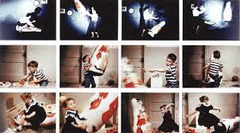
Observational learning

answer
Empathic learning that involves watching the behaviors of others and mirroring them
question
Irrational thought

answer
An unrealistic belief or expectation that may trigger stress, anxiety, and/or feelings of inadequacy
question
Reality orientation
answer
A person's perception of person, place, date, time, and other aspects of the environment
question
Supportive/activity-oriented/resource-oriented music therapy
answer
A level of music therapy treatment that focuses on promoting healthy behavior and fostering participation; treatment goals may include improving social interaction and awareness of others, maintaining reality orientation, managing symptoms, participating in a group experience, controlling impulsive behaviors, and using leisure time in a healthy way; activities may include group singing, playing musical instruments, or engaging in musical games; used with clients with a wide range of functional levels and musical abilities
question
Reeducative/insight-and-process oriented/issue-oriented music therapy
answer
A level of music therapy treatment that focuses on processing interpersonal interactions and emotions; treatment goals may include identifying and expressing emotions, problem solving, increasing self-awareness, and facilitating behavioral changes; used with clients who are well oriented to reality and able to communicate with others in a deep way
question
Reconstructive/analytically and catharsis-oriented music therapy
answer
A level of music therapy treatment that focuses on uncovering, reliving, or resolving subconscious conflicts that impede personality development; used with clients who are highly oriented to reality and are motivated to achieve personal change; requires advanced training
question
Psychodynamic therapy
answer
A philosophical orientation of therapy that focuses on exploring a person's unconscious behavioral and emotional patterns in relation to his or her history; rooted in the work of Sigmund Freud
question
Hospice
answer
End-of-life care provided to people who have a terminal illness and a six-month prognosis; focuses on providing comfort, preventing suffering, relieving pain, optimizing functioning, and improving quality of life
question
Palliative care
answer
End-of-life care provided to people who have a terminal illness regardless of the prognosis; focuses on providing comfort, preventing suffering, relieving pain, optimizing functioning, and improving quality of life
question
Team-oriented approach
answer
An approach in end-of-life care that incorporates the expertise of a variety of professions, including doctors, nurses, social workers, counselors, therapists, and trained volunteers
question
End-of-life care
answer
Treatment provided to people with terminal illnesses
question
Terminal illness
answer
An incurable illness that ultimately leads to death
question
Neuromuscular disease
answer
A disease that affects muscular movement due to damage in the central or peripheral nervous system
question
Bereavement

answer
The process during which a person grieves the death of a loved one
question
Psychosocial
answer
Referring to interrelating aspects of emotional and social functioning
question
Total pain
answer
A term coined by Cicely Saunders to include all of the aspects that influence pain, including emotions, cognition, interpersonal interactions, spirituality, and physicality
question
Assessment tools
answer
Tools used to measure a person's strengths, abilities, and needs; designed based on what is being measured; includes tests, devices, forms, and instruments
question
Numeric Rating Scale (NRS)
answer
An assessment tool that measures a person's experience using a number rating (e.g. On a scale of 1-10, how severe is your pain?)
question
Dyspnea
answer
Shortness of breath
question
Medicare-certified
answer
A medical product or treatment that has been approved by Medicare and is thus covered to the extent that the plan allows
question
Perseverative behavior
answer
Repetitive, stimulative behavior
question
Non pharmacological approach
answer
An approach that minimizes or does not involve medications or drugs
question
Amyotrophic lateral sclerosis (ALS)
answer
A terminal, progressive disease of the motor neurons in the brain stem and spinal cord that eventually leads to muscular paralysis
question
Neurologic music therapy (NMT)
answer
An orientation of music therapy that focuses on the rehabilitation of cognitive, communicative, and physical problems resulting from neurological damage; research-based
question
Rational Scientific Mediating Model (R-SMM)
answer
A model of music perception and production that states that music influences brain and behavior functioning
question
Therapeutic Music Interventions (TMI)
answer
Techniques implemented in therapy that are tailored to the individual client's abilities and needs and address nonmusical treatment goals
question
Aphasia
answer
Impairment of receptive and/or expressive language capabilities
question
Dysarthria
answer
Speech disorder resulting from damage to the neuromuscular systems that control speech production mechanisms
question
Apraxia
answer
Speech disorder that impairs planning and position of speech muscles involved in articulation of words
question
Traumatic brain injury (TBI)
answer
An injury to the brain resulting from an accident; causes include closed head injury, penetrating head injury, and stroke; may result in a coma; results in impairment in physical, cognitive, communicative, and/or social and emotional functioning
question
Rhythmic entrainment
answer
The synchronization of a total movement to an auditory stimulus
question
Audio-spinal facilitation
answer
The stimulation of the motor system by sound that is organized in rhythmic patterns
question
Huntington's disease
answer
A rare genetic neurodegenerative disease; deficient glucose levels in the basal ganglia; loss of control of voluntary movements; most noticeable symptom is choreitic movements (involuntary jerking movements involving the whole body)
question
Multiple sclerosis
answer
A chronic inflammatory disease of the central nervous system caused by demyelination and inflammation in the brain, spinal cord, and optic nerves, resulting in visual, motor, and sensory impairment
question
Biopsychosocial model
answer
A model of treatment that considers the biological, psychological, and social aspects of the human system; contributes to overall health and wellness and the development of coping skills for recovery from illness
question
Opportunistic diseases
answer
Diseases that are acquired when one's immune system is weakened
question
Neonatal Intensive Care Unit (NICU)
answer
A medical environment in which care and treatment are provided to premature and high-risk infants
question
Gate Control Theory of Pain
answer
The theory that the perception of pain occurs in the central nervous system (CNS) and that physical insult to nerve endings throughout the body has the potential to stimulate the opening of neural "gates"
question
Anesthetics
answer
A drug that results in loss of sensation
question
Analgesics
answer
Pain killers
question
Cognitive pain control strategies
answer
Strategies involving the use of thought patterns to manage or reduce the perception of pain
question
Music as a stimulus for active focus or distraction
answer
The use of music for pain management to either draw one's attention toward a positive stimulus or away from an aversive stimulus
question
Music as a cue for relaxation response
answer
The use of music for pain management to reduce muscle tension and increase steady respiration as well as reduce feelings of fear or anxiety
question
Music as a masking agent
answer
The use of music for pain management to cover other noises in the environment
question
Music as an information agent
answer
The use of music for pain management to provide information about the pain involved in a procedure
question
Music as a carrier of information
answer
The use of music for pain management to prepare a person for a painful procedure by providing information about the procedure (doctors involved, when, where, scope of the procedure, etc.)
question
Music as a positive environmental stimulus
answer
The use of music for pain management to provide positive sensory stimulation and promote engagement
question
Normalization
answer
The process of integrating familiar objects, events, and interactions from everyday life in a medical environment
question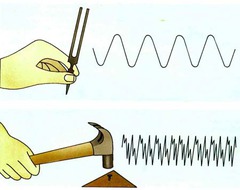
Sound waves

answer
Vibrations that travel through gases, liquids, and solids and are processed by the hearing apparatus
question
Frequency
answer
The number of cycles per second that a sound source vibrates; measured in Hertz (Hz)
question
Pitch

answer
The relative highness or lowness of a sound; determined by frequency
question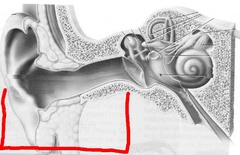
Outer ear

answer
The section of the hearing apparatus that includes the pinna/auricle (ear lobe) and the external acoustic meatus auditory canal/ear canal); funnels sound waves into the ear
question
Middle ear
answer
The section of the hearing apparatus that includes the tympanic membrane (ear drum), the ossicles (malleus, incus, & stapes), oval window, and round window; transmits the mechanical energy of sound waves
question
Inner ear
answer
The section of the hearing apparatus that includes the cochlea; converts sound waves into electrochemical signals that are sent via the auditory nerve to the brain
question
Conductive hearing loss
answer
A type of hearing loss that results from disease, malformation, or obstruction in the outer or middle ear; impairs hearing acuity across a wide range of frequencies; can be remedied with surgery and/or hearing aids
question
Sensorineural hearing loss
answer
A type of hearing loss that results from damage to or absence of cilia in the basilar membrane of the cochlea; may be caused by infections, extended exposure to extremely loud sounds, or congenital conditions; typically impairs hearing acuity for higher frequencies and distorts sounds; can be treated with hearing aids or cochlear implants
question
Mixed hearing loss
answer
A type of hearing loss that combines conductive hearing loss and sensorineural hearing loss in one ear
question
Central hearing loss
answer
A type of hearing loss that results from damage or impairment to the central nervous system; impairs interpretation of sound signals
question
Severity
answer
The degree of an issue
question
Residual hearing
answer
Usable hearing
question
Unilateral
answer
On one side
question
Bilateral
answer
On both sides
question
Age of onset
answer
The age at which a health issue arises
question
Prelingual
answer
Acquired before the development of speech and language skills (0-2 years)
question
Perilingual
answer
Acquired during the development of speech and language (2-4 years)
question
Postlingual
answer
Acquired after the development of speech and language (4+ years)
question
Acute
answer
A serious immediate condition
question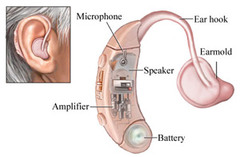
Hearing aids

answer
Devices that amplify incoming sound waves and are worn within the external acoustic meatus; used to treat slight to moderate conductive hearing losses
question
Audiologist
answer
A professional who tests hearing and provides recommendations for treatment
question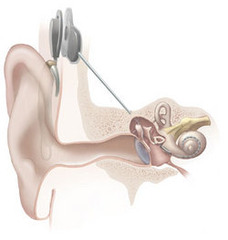
Cochlear implant (CI)

answer
A device that is surgically installed within a person's inner ear and converts incoming sound waves into electrical signals that stimulate the auditory nerve; used to treat severe to profound sensorineural hearing loss
question
Oral communication system
answer
A communication system that includes speech, speechreading (lipreading), and careful listening; rely entirely on residual hearing
question
Manual approach to communication
answer
A communication system that involves signs, fingerspelling, and/or sign languages
question
Fingerspelling
answer
The use of hand shapes to represent individual letters of an alphabet; when used exclusively, it is referred to as the Rochester method
question
American Sign Language (ASL)

answer
A language that makes use of signs, fingerspelling, facial expressions, and body language to communicate thoughts, emotions, and ideas; has its own syntax
question
English-based sign systems
answer
Manual communication that creates the visual equivalents of spoken words through manual symbols; Signed English or Signing Exact English
question
Conceptually Accurate Signed English (CASE)
answer
The use of signs based on meaning and in English-word order
question
Simultaneous Communication (SimCom)
answer
The combined use of speech, signs, and fingerspelling; manual form of communication is often one of the English sign systems or CASE, not ASL
question
Cued speech
answer
The use of signs to assist children in clarifying English speechreading
question
Total Communication (TC)
answer
The use of any or all communication methods (manual and oral)
question
Hearing impairment
answer
A term that refers to all hearing losses regardless of type, classification, or onset; often used in regulatory language; may be considered offensive to some people
question
Hard-of-hearing
answer
Describes a person who uses residual hearing and communicates with speech primarily
question
deaf
answer
Describes a person who has severe to profound hearing loss and cannot use residual hearing functionally
question
Deaf
answer
Describes a person who has severe to profound hearing loss and identifies with Deaf culture
question
Deaf culture
answer
A community of people who share the same values, beliefs, experiences, and practices regarding deafness; may include hearing people who are children or close friends of Deaf individuals; native language is American Sign Language (ASL)
question
Incidental language learning
answer
The learning of language through exposure to adults who utilize the language competently
question
Assistive hearing device
answer
A device used to replace doorbells, alarms, etc. as an accommodation for hearing loss in order to improve an individual's perception of sound
question
Language pragmatics
answer
Rules governing the use of language within a social context
question
Residual vision
answer
Vision that is accessible to a person with low vision or blindness
question
Visual acuity
answer
The extent to which a person can see
question
Blindness
answer
Without vision; a visual acuity of 20/200 or greater in the better eye after correction or 20/200 or less in the better eye without correction
question
Low vision
answer
With partial sight; able to read print and may depend on optical aids to enlarge the print
question
Legally blind
answer
20/200 vision; receives no useful input through vision; uses tactile and auditory senses to acquire knowledge of the environment
question
Functionally blind
answer
Uses Braille for reading and writing; may use functional vision for everyday tasks
question
Tunnel vision
answer
The ability to see objects within an area of only twenty degrees or less
question
Poor central vision
answer
Able to use only peripheral vision
question
Visual efficiency
answer
The efficiency in using residual vision
question
Functional vision
answer
The use of residual vision to complete daily tasks
question
Brown v. Board of Education
answer
A landmark civil rights case that took place in 1954; determined that separate education did not provide equal education
question
Zero reject
answer
In IDEA, the principle that no student should be turned away from receiving FAE, regardless of the severity of one's disability
question
Nondiscriminatory evaluation
answer
In IDEA, the principle that non biased tools must be used to determine whether or not a student's disability negatively impacts his or her education
question
Free and appropriate education (FAE)
answer
In IDEA, the principle that all children are entitled to public education regardless of disability; for students with disabilities, individualized education plans must be established (Individual Family Service Plan for children 0-2 and Individualized Education Plan for children 3-21)
question
Procedural due process
answer
In IDEA, the principle that parents may challenge a decision made by schools
question
Parent and student participation
answer
In IDEA, the principle that parents and students may participate in the development, implementation, and decision-making process related to education services and placements
question
Related services
answer
Services offered to students that are not typically needed for a student to make progress on educational goals; includes physical therapy, speech and language therapy, occupational therapy, and music therapy
question
Full inclusion model
answer
In special education, the model in which students with disabilities are educated in the regular education classroom 100% of the time with support and adaptations
question
Mainstreaming or inclusion model
answer
In special education, the model in which students with disabilities are educated in some general education classes in the regular education classroom and in other classes in a special education classroom
question
Social mainstreaming model
answer
In special education, the model in which students with disabilities join same-aged peers for social interaction opportunities
question
Self-contained classroom model
answer
In special education, the model in which students with disabilities are educated in a special education classroom 100% of the time
question
Separate school or residential school model
answer
In special education, the model in which students with disabilities are educated in a separate school setting
question
Adaptive strategies
answer
In special education, the modification of education for students with disabilities to promote opportunities for successful learning; may include modifying instruction, students' responses, expectations and outcomes, the environment, time to complete task, amount of time participating, difficulty of the material, amount of the material, curriculum, and level of support
question
Collaboration

answer
A professional relationship among service providers, parents, and students that is centered around the common purpose of providing excellent educational opportunities and meeting students' needs
question
Consultation
answer
A professional service offered to other disciplines to provide different perspectives to aid in problem solving
question
Classroom management
answer
The ability to create and sustain an educational environment conducive to learning; strategies include using humor, providing clear directions and expectations, reinforcing positive behavior rather than punishing negative behavior, having a positive attitude, providing an appropriate and motivating curriculum, pacing the session, providing structure and routine, following through with predetermined consequences, tolerating selected behaviors, using proximity control, using planned ignoring, using nonverbal signals to interrupt problematic behaviors, prioritizing problematic behaviors, and removing a misbehaving student from a situation
question
Initial assessment
answer
An assessment conducted prior to the beginning of treatment in order to gather information used to formulate treatment goals and objectives
question
Comprehensive assessment
answer
An assessment conducted if music therapy is the only service provided to a client
question
Ongoing assessment
answer
The process of gathering information throughout the therapeutic process
question
Assessment
answer
The systematic process of gathering information about a client in order to determine present strengths, challenges, and needs; areas of information gathered include medical, physical, cognitive, communicative, affective/emotional, interpersonal, vocational/educational, leisure, spiritual/religious, familial, and musical (history, preferences, responses)
question
Multidisciplinary team
answer
A team that includes professionals who address treatment goals and objectives related to their disciplines
question
Interdisciplinary team
answer
A team that includes professionals who address several treatment goals and objectives and collaborates with team members to develop the goals and objectives
question
Transdisciplinary team
answer
A team that includes professionals who collaborate with each other to address treatment goals and objectives
question
Ethics
answer
A category of philosophy that explores how people should treat themselves and others; morality and laws
question
Confidentiality
answer
The practice of ensuring the privacy of a client's involvement in treatment
question
Dual relationships
answer
Multiple relationships with a client, such as boyfriend/girlfriend, friend, business partner, etc.; must be avoided
question
Scope of practice
answer
The skills and procedures required for a professional to practice competently
question
Informed consent
answer
The process of informing a person of his or her rights and responsibilities in clinical or research practices
question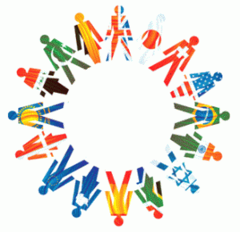
Multiculturalism

answer
The consideration and respect of multiple cultures within a community
question
Approach
answer
A means of accomplishing a goal
question
Model
answer
A generalized, hypothetical way of explaining how something works; a comprehensive approach to assessment, treatment, and evaluation which includes theoretical principles, clinical implications and contraindications, goals, methodological guidelines and specifications, and the use of procedural sequences and techniques
question
Theory
answer
A hypothetical formulation of philosophical ideas that is intended to be analyzed
question
Philosophy
answer
Love of wisdom; the study of the underlying principles that govern the nature of the universe, conduct, thought, knowledge, etc.
question
Method
answer
An orderly approach that involves a procedure, mode, or process
question
Self-actualization
answer
According to Abraham Maslow, the process of becoming the best version of oneself
question
Orff-Schulwerk approach
answer
A music education approach created by Carl Orff (1895-1982) in the 1920s; founded on the principle of elemental music, or a multisensory approach that involves hearing music before learning to read or write music; movement to music and music making with the voice and percussion or melodic instruments such as the recorder, xylophone, glockenspiel, and metallaphone are incorporated; emphasizes creative experience, natural abilities and sounds, the pentatonic scale, and ostinati patterns
question
Eurhythmics approach
answer
A music education approach created by Emile-Henri Jacques-Dalcroze (1865-1950) during the early 20th century; founded on the principle of using movement to teach rhythm, structure, and musical expression; movement to music, singing, improvisation, reading and writing musical notation, and playing instruments are incorporated
question
Kodaly approach
answer
A music education approach created by Zoltan Kodaly (1882-1967) in the 1940s; focused on first teaching a person singing before playing instruments in order to introduce foundations of music; singing, solfege, improvisation using the pentatonic scale, and reading and writing musical notation are incorporated
question
Nordoff-Robbins Music Therapy
answer
A music therapy approach created by Paul Nordoff and Clive Robbins beginning 1959; each person has a "music child" and can achieve self-actualization through improvisation and active music making
question
Humanistic
answer
A philosophical approach in psychology that holistically considers human experience; the highest need of a human being is to achieve self-actualization
question
Transpersonal
answer
A philosophical approach in psychology that suggests that a person can go beyond himself or herself to achieve personal growth
question
Self-awareness

answer
The process of recognizing and acknowledging one's inner experiences (thoughts, emotions, sensations, etc.) in response to internal or external stimuli
question
Imagery
answer
Internal thoughts, emotions, visualizations, sensations, etc.
question
Behavioral therapy
answer
A psychological philosophy that focuses on the development of maladaptive behavioral patterns and how they can be changed through specific interventions
question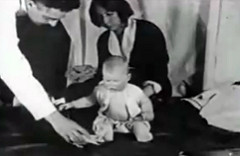
Classical conditioning

answer
An unconditioned stimulus elicits an unconditioned response, and when the unconditioned stimulus is paired with a neutral stimulus, which then becomes a conditioned stimulus, a conditioned response results; e.g. using hand clapping to signal silence in a classroom
question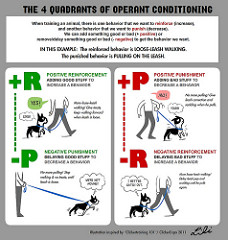
Operant conditioning

answer
The use of positive or negative reinforcement or punishment to change behavior
question
Positive reinforcement

answer
A positive stimulus is presented in order to increase a positive behavior
question
Negative reinforcement
answer
Encouraging positive behavior by removing a negative experience
question
Punishment
answer
Discouraging negative behavior by offering a negative consequence
question
Empirical methods
answer
Quantifying observable and measurable behaviors
question
Applied Behavior Analysis (ABA)
answer
A form of behavioral therapy used to change behavioral patterns; often used in school settings
question
Extinction
answer
The removal of negative behaviors
question
Token economies

answer
A system in which a person is rewarded a token for positive behavior, and a certain number of tokens can be exchanged for a positive reward
question
Shaping
answer
A technique for developing new behaviors by reinforcing successive approximations of the desired behavior
question
Autogenic/progressive relaxation
answer
A behavioral technique used to relax the muscles, improve the flow of oxygen within the body, and reduce anxiety and fear; often paired with music and/or verbal guiding interventions
question
Psychoneuroimmunology
answer
The study of the relationships among the mind, brain, and immune system
question
Integrative approach
answer
A therapeutic approach that draws from several methods, theories, philosophies, and models in order to best meet the therapeutic needs of clients
question
Research
answer
The process of collecting, analyzing, and interpreting data in a reliable, orderly way in order to answer a specific question and produce new knowledge
question
Descriptive research
answer
Research intended to describe a state of something as it is
question
Quantitative research
answer
Research that involves the collection of numerical information; seeks to determine an objective truth or fact
question
Generalization
answer
The ability to transfer or apply responses to a different set of stimuli, a new setting, or another behavior; in research, the applicability to other members of the entire population studied
question
Experimental research
answer
Quantitative research conducted to determine the effects of independent variables on specific situations; conducted within a controlled environment
question
Variable
answer
A factor that influences a specific outcome; independent & dependent
question
Hypothesis
answer
A statement that predicts the results of an experiment based on preexisting knowledge
question
Cost-benefit ratios
answer
Comparisons of the costs and benefits of an intervention to determine its effectiveness
question
Random assignment
answer
A procedure conducted within experimental research in order to minimize bias and confounding variables
question
Hemiplegia
answer
Paralyzed on either the left or right side of the body
question
Mean
answer
The average of a set of data points
question
Range
answer
The difference between the largest data point and the smallest data point
question
Pretest
answer
Testing conducted before an experiment or prior to a therapeutic intervention
question
Posttest
answer
Testing conducted after an experiment or following a therapeutic intervention; compared with pretest results
question
Experimental blindness
answer
A tester involved in a research study who is not aware of the interventions or research questions being studied; minimizes bias
question
Historical research
answer
Research that studies the past in order to make connections with the present
question
Qualitative research
answer
Research that involves collecting various perspectives in order to achieve a deeper understanding of an experience; sometimes referred to as naturalistic research
question
Ontology
answer
A worldview
question
Protocols
answer
Steps or approaches
question
Client-centered
answer
In therapy, encouraging the client to direct the therapeutic experience and make decisions about treatment
question
Methodological integrity
answer
According to Kenneth Bruscia, qualitative research must include methods that are appropriate and congruent with the research question(s) being answered
question
Personal integrity
answer
According to Kenneth Bruscia, qualitative research must be conducted by a researcher who is present and honest
question
Interpersonal integrity
answer
According to Kenneth Bruscia, qualitative researcher must incorporate the ideas of the researcher(s) and the participant(s) in a distinctive way, and the impact of the beliefs of the researcher(s) must be considered
question
Aesthetic integrity
answer
According to Kenneth Bruscia, qualitative research must be conducted in a creative way to produce meaningful outcomes
question
Acquired hearing loss
answer
A hearing loss that develops after birth
question
Adaptive behavior
answer
Behavior that changes to fit the demands of a situation
question
Aesthetic enjoyment
answer
The appreciation of the beauty or importance of a creative work (art, music, drama, dance, literature, poetry, etc.) without necessarily being entertained
question
American Association on Intellectual and Developmental Disabilities (AAIDD)
answer
Formerly the American Association on Mental Retardation (AAMR); a professional organization comprised of professionals who work with and/or support people with intellectual or developmental disabilities
question
Arthritis

answer
The inflammation or deterioration of the joints
question
Auditory nerve
answer
Nerve fibers that carry electrochemical signals from the cochlea to the temporal lobes of the brain, which interpret the signals as sounds
question
Authentic
answer
Referring to historical research that is based on sound evidence rather than speculation
question
Autism
answer
A pervasive developmental disorder characterized by impairments in speech and language, sensory processing, behavior, and interpersonal interaction; on a spectrum of disorders
question
Basilar membrane
answer
The lining inside the cochlea that consists of thousands of cilia that convert sound waves into electrochemical signals that travel through the auditory nerve to the brain for processing
question
Bilingual-Bicultural approach to language learning
answer
A method in which a Deaf child is taught ASL as his/her primary language and English as his/her secondary language in order to communicate in both the Deaf and hearing communities
question
Cadence
answer
In gait training, the rhythmicity of a person's steps
question
Catatonic behavior
answer
Remaining in the same position for long periods of time without moving
question
Cilia
answer
Hair cells in the basilar membrane of the cochlea that covert sound waves into electrochemical energy
question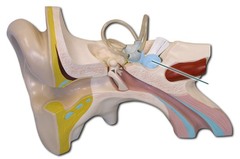
Cochlea

answer
A small, snail-shaped structure in the inner ear that is responsible for converting the mechanical energy of sound into electrochemical energy
question
Cognitive behavior modification
answer
A behavior modification technique that involves self-reinforcement and self-evaluation
question
Compression
answer
An increase in density of air molecules
question
Compulsions
answer
Urges to act upon obsessions in order to relieve anxiety; repetitive, ritualistic behaviors
question
Configuration of hearing loss
answer
The extent of hearing loss at each frequency and the overall prospect of hearing that is created
question
Degree of hearing loss
answer
The severity of hearing loss; mild, moderate, severe, or profound
question
Delusions
answer
Unshared beliefs that lack evidence in reality
question
Developmental disability
answer
A chronic condition that begins before the age of 18 and progressively worsens over time; includes intellectual disabilities; autism spectrum disorders; and sensory, motor, physical, or cognitive impairments; results in substantial functional limitations in three or more areas of the following life activities: self-care, learning, mobility, self-direction, economic sufficiency, receptive and expressive language, and capacity for independent living
question
Direct instruction
answer
A teaching method that involves the use of lecture or demonstration rather than hands-on learning or group discussion
question
Disorganized speech
answer
Incoherent or illogical speech
question
Divided attention
answer
Attention on two or more stimuli at the same time
question
Dyspraxia
answer
A speech impairment resulting from an inability to plan and position the muscles involved in word articulation
question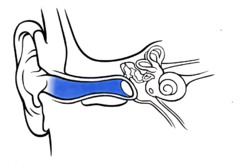
Ear canal

answer
Auditory canal/external acoustic meatus; the part of the outer ear that funnels in sound waves from the external environment
question
Early intervention program
answer
A special education program implemented under IDEA that serves children with special needs under the age of three
question
Electrochemical energy
answer
Energy controlled by chemical changes resulting from an electrical current; e.g. neural signals in the brain
question
Electroconvulsive therapy (ECT)
answer
A therapy involving the discharge of electricity into the brain; used as a last resort to treat severe depression
question
Emergent
answer
A research design in which the steps of research unfold organically as the research is carried out
question
Entertainment
answer
The use of music for enjoyment in order to amuse or divert from everyday cares
question
Episodes
answer
In a behavioral-emotional disorder, discrete periods of time during which a person experiences symptoms that reflected a marked change from previous functioning; e.g. becoming manic after being depressed for two months
question
Glasgow Coma Scale (GCS)
answer
An assessment tool used to measure eye movement, motor response to stimuli, and verbal response in a person with a coma
question
Grossly disorganized behavior
answer
Dysfunctional behavior that causes distress over a significant period of time
question
Hallucinations
answer
Unshared sensory experiences that are not stimulated in reality
question
Harmonics
answer
Overtones that occur in periodic patterns
question
Hertz (Hz)
answer
A measure of sound frequency; 440 Hz = A above middle C
question
Individual Family Service Program (IFSP)
answer
An individualized treatment program for a child under the age of three who qualifies for Early Intervention under IDEA
question
Leo Kanner
answer
A psychiatrist who identified autism as a distinct developmental disorder in the 1940s
question
Locomotion
answer
The act of moving from place to place
question
Mechanical energy
answer
Energy controlled by physical forces
question
Mental retardation
answer
A term that was a precursor to the term intellectual disability
question
Mobility
answer
Movement from a present position to a desired location in space; locomotion
question
Neuropsychologist
answer
A professional who studies psychology from a neurological perspective; believes that psychological functioning results from the anatomy and physiology of the nervous system
question
Obsessions
answer
Intrusive, persistent thoughts that trigger anxiety; e.g. "The germs are going to kill my baby."
question
Onset of hearing loss
answer
The age at which a hearing loss develops
question
Ossicles

answer
Three small bones in the middle ear that transmit the mechanical energy of sound to the inner ear; malleus, incus, and stapes
question
Overtones
answer
Harmonics; frequencies that sound above the fundamental tone of a pitch
question
Perceptual processing
answer
Organizing or interpreting sensations
question
Orientation
answer
The ability to establish one's position in relation to person, place, time, and date
question
Periodic
answer
The regular repetition of compression and rarefaction in sound waves
question
Phenomenological research
answer
The examination of the human experience from the subjective perspectives of the participants in the research study in order to develop patterns of meaning
question
Phenylketonuria (PKU)
answer
A genetic metabolic disorder that causes severe brain damage; results from the inability to break down phenylalanine
question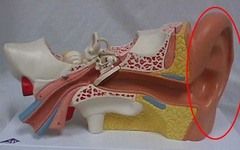
Pinna

answer
Auricle; the outer portion of the ear the funnels sound waves into the ear canal
question
Rank order
answer
An organization of data points hierarchically
question
Rarefaction
answer
A decrease in density of air molecules
question
Severity of hearing loss
answer
The extent to which hearing is lost and the range of communication difficulties that result
question
Shifting attention
answer
The alternation of attention from one stimulus to another
question
Significant difference
answer
In quantitative research, the claim that the difference between two results is less likely to happen by chance; the difference will happen by chance no more than 5% of the time
question
Rochester method
answer
A method of manual communication that involves only fingerspelling and speech sounds
question
Sensory processing
answer
The ability to organize and interpret sensations
question
Social Communication Training
answer
Activities and exercises used to improve a person's social pragmatics and interpersonal skills
question
Social stories
answer
Narrative tools used to teach individuals with autism how to respond within a social situation
question
Sound comprehension
answer
The ability to understand and describe a sound
question
Sound detection
answer
The ability to distinguish between sound and silence; auditory awareness
question
Storage
answer
The retaining of information in the form of memories following adequate rehearsal
question
Stride length
answer
The distance a person travels with each step
question
Sustained attention
answer
The ability to attend to a stimulus for a given period of time
question
Symmetry
answer
The similarity of a person's left and right steps in gait training
question
Tactile defensiveness
answer
Oversensitivity to touch
question
Sound discrimination
answer
The ability to determine whether or not two sounds are the same or different; auditory discrimination
question
Transformational Design Model (TDM)
answer
A framework of music therapy treatment that involves 1) assessing the client, 2) determining treatment goals and objectives, 3) determining functional nonmusical activities, 4) converting those activities into musical interventions, and 5) generalizing training into real-life situations
question
Tympanic membrane
answer
Ear drum; a thin membrane at the end of the ear canal that vibrates in response to sound waves and augments the sound waves, which are then transferred to the ossicles
question
Velocity
answer
The speed at which a person walks; the number of steps taken within a given period of time
question
Vibrotactile aid
answer
A mechanism used with people who are deaf or hard of hearing to sense and interpret the vibrations of sounds through the sense of touch
question
Attention deficit disorder
answer
A pervasive disorder characterized by attention difficulties, hyperactivity, or impulsiveness; onset often occurs before age seven
question
Auditory memory
answer
The ability to retain and recall a sound that is heard
question
Auditory-motor match
answer
The process of auditory awareness leading to movement in response to the sound stimulus; related to rhythmic entrainment
question
Communication disorder
answer
A disorder impairing the transfer of thoughts or ideas through speech, written word, and/or nonverbal means
question
Disruptive behavior disorder
answer
A type of conduct disorder characterized by oppositional and defiant behavior which does not meet the criteria for other conduct disorders
question
Fine motor dexterity
answer
The coordination of small muscles
question
Forensic psychiatry
answer
The branch of psychiatry devoted to legal problems and infractions of the law, primarily criminal
question
Hyperactivity
answer
A behavior characterized by increased or excessive muscle activity; a symptom of ADHD
question
Juvenile offenders
answer
Children or adolescents who have committed criminal offenses
question
Learning disorder
answer
A disorder characterized by an impairment in information processing; often caused by damage to the brain or perceptual-motor deficiencies
question
Motor skills disorder
answer
A deficit in muscular coordination that is diagnosed in childhood
question
Multiply handicapped
answer
A condition involving two or more physical or sensory impairments
question
Oppositional defiant disorder
answer
A condition characterized by consistent hostile or negative behavior, resulting in dysfunction
question
Physical challenges/impairment
answer
A broad term for any condition of the body that causes dysfunction
question
Physical therapy/physiotherapy
answer
A rehabilitative treatment of physical impairment that may involve hydrotherapy, heat, massage, and/or exercise
question
Pitch-matching
answer
The imitation of a tone
question
Sensory impairment
answer
A condition that limits contact with the environment through the senses (hearing, sight, touch, taste, smell, kinesthesia)
question
Williams syndrome
answer
A neurobehavioral congenital disorder characterized by delayed motor development, mild to moderate intellectual disability, and impairment in visual and spacial functioning; often display hyperacusis, responsiveness to music, and social and verbal fluency
question
Accountability
answer
The process by which one is responsible, credible, and answerable for obligations to a set of constituencies
question
Data-based model
answer
An approach of gathering objective information to measure progress; occurs through experimentation or direct observation
question
Dysphoric
answer
An emotion characterized by dejection, misery, and underestimation of self
question
Empathy
answer
The ability to recognize and identify emotions in oneself and in others, assume the perspective of another, and help another compassionately
question
Goal
answer
A statement of purpose or direction for therapy; an expected outcome; can be long-term or short-term; stated in broad terms
question
Objective
answer
A measurable, observable step toward a therapeutic goal; can be short-term or long-term; stated in specific terms; may include the conditions under which the expected outcome will occur
question
Insight
answer
The self-awareness and knowledge of personal strengths and issues
question
Target behavior
answer
A behavior or set of behaviors that can be measured; attained by working toward therapeutic goals and objectives
question
Termination
answer
The process of ending the therapeutic relationship between a client and therapist and discontinuing music therapy services; includes comprehensive review of treatment and recommendations for future treatment
question
Auditory learners
answer
Individuals who learn more effectively through listening
question
Fibromyalgia
answer
Myofascial pain syndrome; a nonarticular rheumatic disorder characterized by pain, stiffness, and extreme tenderness in the muscles
question
Hyperacusis
answer
An extreme sensitivity to sound and an ability to make fine auditory discriminations
question
Contract
answer
A mutually agreed upon set of expectations, rules, and policies that both the therapist and client are obligated to follow
question
Metaphor
answer
In therapy, the concept that behaviors demonstrated in the music therapy environment are generalized to other contexts in daily life
question
Rapport
answer
Closeness or trust that is developed beginning at the first therapy session
question
Reinforcement value
answer
The degree to which an activity or material is likely to reinforce a behavior
question
Contract
answer
A mutually agreed upon set of expectations, rules, and policies that both the therapist and client are obligated to follow
question
Metaphor
answer
In therapy, the concept that behaviors demonstrated in the music therapy environment are generalized to other contexts in daily life
question
Rapport
answer
Closeness or trust that is developed beginning at the first therapy session
question
Reinforcement value
answer
The degree to which an activity or material is likely to reinforce a behavior
question
Perceptual-motor
answer
The organization and interpretation of a stimulus and its motor response
question
Reliability (test-retest)
answer
The consistency of a test or observation and its ability to be generalized
question
Sensory-motor
answer
The combination or processing of a sensory stimulus and a motor response
question
Validity
answer
The degree to which a test or observation measures what it intends to measure
question
Inter-observer agreement
answer
A measure of reliability that states that two or more observers witnessed the same behavior or event
question
Response definition
answer
A behavioral description of a target behavior that includes a concise descriptive term, boundaries or limits for behaviors, observational strategies, and examples of borderline responses
question
Terminal objective
answer
The final objective that leads to the completion of a goal
question
Anecdotal record
answer
A detailed description of a behavior and events that are observed
question
Antecedents (antecedent stimuli)
answer
Events that occur prior to a given behavior that may influence the behavior
question
Baseline
answer
A behavior that occurs without the influence of a therapeutic intervention
question
Consequences
answer
Events that occur after a given behavior that may influence the reoccurrence of the behavior
question
Duration recording
answer
An observational method that involves noting the amount of time that a behavior occurs
question
Frequency count
answer
An observational method that involves noting the number of times that a behavior occurs
question
Interval time-sampling
answer
An observational method that involves noting whether or not a behavior occurs within a given period of time
question
Planned Activity Check (Pla-Check)
answer
An observational method used in a group setting that involves noting the number of group participants who are engaging in a target behavior by the end of a predetermined observational period
question
Reliability coefficient
answer
Used to determine inter-observer agreement; the number of agreements between two observers divided by the summation of the agreements and disagreements between two observers times 100%
question
Cue (stimulus, prompt)
answer
An event that is presented to stimulate a behavior or event
question
Discriminative stimulus
answer
A cue that stimulates a response that only occurs when said cue is presented
question
Fading
answer
The gradual removal of cues in order to maintain the behavior on its own
question
Group contingencies
answer
A consequence provided to an entire group of people when one or more members of the group engage in a specific behavior; e.g. the whole class stays in for recess when Johnny and Tammy distract the class from the lesson on numerous occasions
question
Insight therapy
answer
A type of therapy that seeks to develop an awareness of causes or motivation for behavior in order to develop increased control over the behavior and improve one's condition
question
Negative punishment
answer
Removing a positive stimulus in order to reduce maladaptive behavior
question
Paired-associate
answer
The presentation of one word as a stimulus for the recall of a second word
question
Psychiatric musicology
answer
A music therapy approach that seeks to increase understanding of interpersonal relationships through music
question
Rational emotive therapy
answer
An orientation of psychotherapy developed by Albert Elis which proposes that one's thought patterns lead to emotional patterns; seeks to confront thought patterns and change them to solve problems
question
Schedule of reinforcement
answer
The frequency with which stimuli are presented to increase or decrease behavior; may be fixed or variable, based on interval or ratio criteria
question
Successive approximations
answer
Behaviors which gradually resemble the target behavior or terminal objective; developed through shaping
question
Transactional analysis
answer
An orientation of psychotherapy proposed by Eric Berne which exams interactions in terms of explicit roles and games as a method of recognizing and understanding patterns of behavior
question
Baseline-treatment design
answer
A design of treatment in which a client's baseline behaviors are assessed without music therapy intervention before treatment is initiated
question
Case studies
answer
A design of treatment involving an individual client or a single group to determine the effectiveness of music therapy treatment over time
question
Experimental group design
answer
A design of treatment that involves controlling environmental and treatment conditions in order to determine whether or not music therapy treatment causes behavioral changes
question
Hierarchy of objectives
answer
A list of objectives that are to be met sequentially based on developmental, task, or social steps in order to lead to the terminal objective
question
Matched pairs design (correlated or equivalent groups)
answer
An experimental group design in which each group participates in the experimental group and control group followed by a comparison of the performances
question
Multiple baseline design
answer
A single subject, applied behavior analysis design in which a treatment is added successively to two or more subjects, behaviors, settings, or other similar units while other conditions are held constant
question
Pretest-postest design
answer
A treatment design which measures behavioral responses before and after treatment
question
Random group design (randomized subjects)
answer
An experimental group design in which subjects are randomly assigned to the experimental and control groups in order to control conditions
question
Repeated measures design
answer
An experimental group design in which subjects are observed repeatedly under different treatment or no treatment conditions
question
Reversal design (ABAB design)
answer
A single subject, applied behavioral analysis design in which behavior is first observed without treatment, when treatment begins, when treatment is removed, and when treatment is continued
question
Single subject, applied behavior analysis design
answer
A research design that assesses the effect of treatment on one client or a group of clients over time
question
Task analysis
answer
A detailed breakdown of the behaviors involved in a single task listed in order of occurrence
question
Transference
answer
The client's projection of thoughts, emotions, ideas, or desires about others onto the therapist; e.g. TN stated that his music therapy intern was his sister.
question
Countertransference
answer
The therapist's projection of thoughts, emotions, ideas, or desires about others onto the client; e.g. A reminds me of my father.
question
Secondary gains
answer
"Side effects," or other results of music therapy treatment other than the accomplishment of the terminal objective(s)
question
Treatment plan
answer
A program of therapeutic or educational intervention which focuses on the needs and strengths of the individual client; includes target behavior(s), response definition(s), goal(s), objectives, procedures, and methods for evaluation and generalization techniques
question
Screening
answer
The process of determining whether or not a client should receive music therapy services
question
Appropriate norms
answer
Standardized tests whose interpretations are based on data derived from normally functioning populations
question
Criterion-referenced assessment
answer
An assessment designed with the client's level of functioning in mind
question
Evaluation
answer
The process of determining the effectiveness of therapeutic interventions thus far; the treatment plan may be modified in response to evaluation results
question
Safety
answer
Avoidance of harm through structuring care processes, supplies, equipment, and the environment to reduce or eliminate injuries, infections, and care errors
question
Best professional judgment
answer
The use of knowledge from the field of music therapy and other related fields in order to make educated decisions regarding the provision of music therapy treatment
question
Advanced level of practice
answer
The application of process-oriented or outcome-oriented music therapy methods to address a broad spectrum of client needs from a professional music therapist who demonstrates an in-depth knowledge, understanding, and application of theories, research, treatment, musicianship, clinical skills, and personal awareness
question
Advanced training
answer
The learning of a comprehensive approach to music therapy intended for broad and in-depth clinical education; the training takes place over an extended period of time and includes opportunities for didactic instruction and extensive, supervised clinical application; the master's degree is typically required as a prerequisite or co-requisite
question
Comprehensive
answer
Thorough and complete
question
Construct
answer
A working hypothesis or concept
question
Dynamics
answer
Forces that interplay within the mind as a manifestation of purposeful intentions working concurrently or in mutual opposition; include the patterns of actions and reactions within the music, therapist, and client triangle and within groups
question
Experience
answer
A client's engagement with music; can be recreative, improvisational, composition, or receptive
question
Knowledge
answer
Facts or ideas acquired through observation, study, investigation, or experience
question
Musical responses
answer
The musical actions or reactions of a client in response to internal or external stimuli and the physiological, affective, motor, cognitive, or communicative responses to musical stimuli
question
Primary therapist
answer
The clinician who conducts the most important therapeutic work
question
Process
answer
A sequence of conscious and unconscious events that leads to change within the music, therapist, and client triangle
question
Supervision
answer
The process of seeking support from another health care professional, whether a music therapist or non-music therapist, in order to further one's growth as a music therapist
question
Technique
answer
A single intervention that leads to an immediate response from a client or shapes the ongoing, immediate experience of the client
question
Understanding
answer
Knowledge of something and its applications
question
Creative movement
answer
Movement that is produced freely without the necessity of following a provided beat
question
Synchronized movement
answer
Movement that is produced to follow a provided beat
question
Individualized Program Plan (IPP)
answer
An individualized treatment plan for adults with disabilities
question
Behavior disorder
answer
A difficulty or problem with a person's attitude or behavior that negatively impacts his or her functioning abilities
question
Baseline task
answer
An activity that a client can complete easily
question
Prompted task
answer
An activity that requires focus and additional support or cuing from the therapist
question
Independent task
answer
An activity that the client is instructed to engage in independently without prompting from the therapist
question
Collaborative task
answer
An activity during which the client works with the therapist and/or peers
question
Functional analysis
answer
The process of gathering and interpreting information regarding the antecedents and consequences that affect a given behavior; should be conducted in the environment in which the behavior typically occurs
question
Independent variable
answer
In an experimental design, the variable that is manipulated to affect the dependent variable
question
Dependent variable
answer
In an experimental design, the variable that is affected by the manipulation of the independent variable
question
Clinical
answer
Attention to a client's condition(s) and problematic experience(s); describes therapy that is scientifically based
question
Clinical improvisation
answer
A music therapy intervention during which the client(s) and the therapist extemporaneously make music; the improvised music often reflects aspects of the client(s)' personality at a conscious or unconscious level
question
Evidence Based Practice
answer
A standard for health care practice that requires therapeutic interventions to be founded on scientific research and characterized as valid and reliable
question
Behavioral music therapy
answer
The use of music by a music therapist as reinforcement or punishment to modify or increase positive behavior and reduce or eliminate negative behavior
question
Psychotherapeutic music therapy
answer
The use of music by a music therapist to help clients increase their awareness and understanding of thoughts, emotions, attitudes, issues, and relationships
question
Educational music therapy
answer
The use of music by a music therapist to help students reach their educational goals and objectives
question
Auxiliary level of music therapy
answer
The implementation of music therapy techniques by non-music therapists
question
Augmentative level of music therapy
answer
The implementation of music therapy techniques to enhance a therapeutic plan
question
Intensive level of music therapy
answer
The implementation of music therapy techniques as an independent and significant form of treatment
question
Primary level of music therapy
answer
The implementation of music therapy techniques as a primary form of treatment



